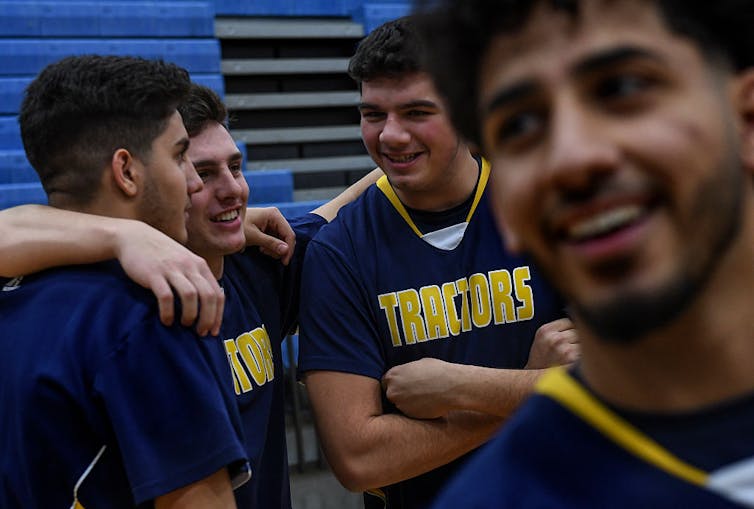Cochineal, a red dye from bugs, moves to the lab
Carminic acid is a bright, natural coloring used in some cosmetics and foods. It’s traditionally sourced from ‘farming’ an insect on acres of prickly pears. Today, scientists are moving to engineer it in microbes.
An average trip to the grocery store can yield a cartful of colorful foods. Bright among the rainbow are the reds, lending hues to products such as raspberry jam, canned cherries, strawberry licorice and red velvet cake. Often, their source is a certain small insect.
Cochineal bugs — oval-shaped scale insects around 0.2 inches long — are harvested and turned into the natural dyes cochineal extract, carmine and the pure pigment carminic acid. They have been used to color food, textiles and cosmetics for centuries.
Today, though, traditional labor-intensive harvesting methods are under strain due to rising demand, and prices for the natural pigment have increased. So some scientists are exploring genetic engineering to produce carminic acid in what they hope could be a cheaper, faster and more sustainable way. The efforts, though experimental right now, could also appease those who want non-animal sources of the colorants in their foods, these scientists say.
“It has the potential for a paradigm shift for the production of that compound,” says synthetic biologist Rasmus J. N. Frandsen of the Technical University of Denmark.
The story of carminic acid traces back thousands of years to bright red Phoenician garments colored by a crushed scale insect of the Kermes genus. Hues harvested from the bug’s cousin from the Americas, Dactylopius coccus, graced scarlet goods during the reigns of the Mayan and Aztec empires. In the 1500s, Spaniards documented widespread cochineal harvesting in the New World along with the preparation and trade of the dye. Entranced by the bold color, they shipped dried insects by the ton back to Europe to replace the drabber dyes then in use there.
The scarlet spread across the world like wildfire: It funded empires, stained religious garb and was showcased in masterpiece paintings — becoming a precious commodity rivaling silver and gold.
Use of carminic acid in its various forms in textiles and art waned with industrialization and development of synthetic dyes in the mid-1800s, says biomedical dye chemist Dick Dapson of the Biological Stain Commission, which tests and certifies dyes. But the pigment continued to color food, drugs and cosmetics to enhance their appearances. Between 1967 and 2009, the US Food and Drug Administration gradually approved cochineal extract and carmine for such purposes, and these cochineal insect derivatives still add color to various yogurts, cakes, candies, beverages and meats.
Use of a bug extract in food shouldn’t alarm, says University of Guadalajara biotechnologist Liberato Portillo Martinez, who has studied cochineal insects for decades. The amount of insect remaining in the pigment is minuscule — and besides, he adds, many food products are deemed safe and approved for sale even if they contain small amounts of whole or fragmented insects.
Today, Peru is the largest commercial producer of the D. coccus cochineal insect, followed by countries such as Mexico, Chile, Argentina and Spain’s Canary Islands. Many aspects of production remain the same as they were thousands of years ago. Workers start by rearing the bug on its plant of choice, the prickly pear (also known as the pear cactus or nopal) of the Opuntia genus. The insects are dried and sold to processors, who extract carminic acid, which makes up around 20 percent in dry weight of the cochineal insect’s body.
Mills the size of phone booths grind the bugs to powder. Then the powder is paired with salts to isolate carmine — the commonly sold product of cochineal insects that’s 50 percent to 60 percent carminic acid.
With current harvesting methods, an estimated 70,000 bugs are needed to produce one pound of dried insect and a fifth of a pound of carminic acid. “It is time-consuming labor, but there is something funny about it: If you start working with cochineal, you fall in love with it,” Portillo Martinez says.
The use of carminic acid from cochineal insects has fluctuated over time. The rise of synthetic dyes, which were cheaper to produce, caused a decline in use of cochineal insects starting in the mid-1800s. But from around the 1970s, health concerns about these synthetics began to mount — stemming from reports of a link between the colorings and hyperactivity in kids, as well as some cell and animal studies suggesting that certain dyes may raise risk of cancer. This prompted the eventual ban of some of them, such as Red 2 and Red 4. Dyes of natural origin, like carminic acid, began to grow more popular as a result, Dapson says.
Synthetic dyes are still widely used in American foods, and there are growing numbers of vegans, vegetarians and animal-rights activists who don’t want to inadvertently eat an insect product like carmine. Some studies have reported allergic reactions to cochineal dye in a small proportion of people due to residual insect molecules — but at levels no higher than for other common allergens, Frandsen says.
Still, overall global demand for carminic acid is projected to increase as industries source it for coloring sweets, drinks, jams and meats. This, along with climbing costs of labor, is straining the cochineal industry. In Peru, the price per ton of carmine dye rose 40 percent between 2013 and 2019.
“Habitat for cacti is limited, growth of both host and parasite are slow, and extraction procedures are woefully inefficient,” Dapson says. “Improvements in extraction and purification have been made, but they don’t address the core problem, which is production of the insects.”
Biochemical challenges
In recent years, researchers have turned to metabolic engineering — the manipulation of natural cellular reactions to yield desired products — to see if they can devise a sustainable solution to the production bottleneck as well as to address concerns about animal additives and allergies. The idea is to biosynthetically manipulate metabolic pathways inside microbes to create carminic acid.
And there are other possibilities: “In addition to making the carminic acid, we will be able to make a bit of change in the carminic acid as well. We could do better colors and maybe better biological activity,” says microbial engineer Yong-Su Jin of the University of Illinois at Urbana-Champaign, who wrote about emerging genetic technologies in producing food colors and flavors in the 2022 Annual Review of Food Science and Technology.
But there are challenges. For one, carminic acid has a complicated structure: a central three-ring structure called anthraquinone to which a glucose molecule and a few other chemical groups are attached. That makes it difficult to synthesize in large amounts, says industrial chemist David Bott of the Society for Chemical Industry.
Scientists still don’t even know the full biochemical pathway that cochineal insects use to make the compound, Frandsen says. And so, almost a decade ago, his team decided to start with the structure of the end product — carminic acid — and figure out how to reverse-engineer it with enzymes from known biochemical pathways.
“Take a rocket, for example,” he says. “You don’t know how it works, but you can see that it flies, right? How do we get the different parts? What should be combined to get this?”
Frandsen and colleagues began by predicting the needed starting ingredients and biochemical steps, as well as enzymes to catalyze those steps. They devised eight potential biochemical pathways that might create carminic acid and tested several hosts to do their genetic engineering in, eventually settling on a well-studied fungus called Aspergillus nidulans. It was easy to analyze yet complex enough to provide the key chemical ingredients for the reactions.
Through trial and error, the team created the three-ring core of carminic acid after deleting some genes from the fungus (to disable competing biochemical pathways) and adding several others (one from a plant and two from bacteria) that provided the appropriate enzymes. This core was then processed by an unknown enzyme already in Aspergillus to produce an intermediate structure called kermesic acid.
Finally, addition of a gene from the cochineal insect itself provided an enzyme that converted kermesic acid into carminic acid. When the fungus was engineered with all these genes, the broth in which it was growing turned red, and tests confirmed the presence of the dye in the broth and in the fungus.
The team’s paper, published in 2018, provided proof of principle that a microbe could be engineered to make carminic acid. But the efficiency of the reaction was nowhere near high enough to consider large-scale manufacturing, Frandsen says. And because one of the enzymes remained unknown, it would be hard to optimize production.
“It was a long struggle with lots of things that should work in theory, but which did not in the real world,” he says. “The truth about synthetic biology is that it is very early days, and results are often presented as, ‘We just did it and it was easy,’ while the reality is way different.”
A 2021 study by another team devised an alternate biosynthetic pathway for carminic acid, this time introducing genes into the well-known bacterium E. coli, chosen for its ease of manipulation and potential for large-scale manufacturing. The work differed in its approach from the 2018 work in a number of ways and also reported how much of the compound was produced, says metabolic engineer Sang Yup Lee of the Korea Advanced Institute of Science and Technology, senior author of the work.
Among other things, the scientists were able to build a biosynthetic pathway in which every step was known (unlike the Aspergillus work with its unknown fungus enzyme). For the last step in the pathway, they used an enzyme from a plant instead of one from the cochineal bug. When the process still wasn’t producing carminic acid, the team conducted computer modeling studies to predict structural changes in some of the enzymes that would enhance the efficiency of the biosynthetic pathway. Then they introduced those changes by making precise mutations in the genes.
Finally, starting with glucose — which can be produced from renewable biomass — they successfully produced carminic acid.
While the scale of the experiment was tiny, the scientists calculated that if it were scaled up, and assuming production of 5 grams of carminic acid per liter, growing the engineered E. coli for five days in a 100,000-liter fermenter could produce as much carminic acid as cochineal bugs growing on prickly pear pads would produce on a hectare (almost 2.5 acres) of land in a year.
Frandsen says the two studies show that it’s possible to create novel biosynthetic pathways without directly copying the pathway used in nature (although he’d still like to uncover the biochemical processes that the cochineal insects use to make carminic acid). “Both show that synthetic biology has a great potential for the future,” he says.
There is still a lot of work to do before the process could be scaled up to industrial levels, the scientists add. Researchers need to fiddle with the amounts or efficiency of the various enzymes engineered into the microbes to optimize the production of carminic acid and reduce the amounts of undesired byproducts. Nonetheless, Frandsen and Lee say that companies are already taking interest, although they would not disclose names.
Making carminic acid this way could quell consumer concerns about animal products and possible allergies, but some may still balk over fears about genetically modified foods. Still, Lee says, “we hope that consumers around the world who care for the environment and health … will actively consume food and cosmetics containing microbially produced carminic acid. With our additional effort and time, we think we can get there in the near future.”
As for those prickly pear cacti in their plantations, ready to be fed to sucking cochineals to fatten them before their demise — Portillo Martinez reckons they’ll stick around to some extent regardless, due to long-standing local traditions.
“There are many, many areas that use the cochineal,” he says. “I think its production will remain. Maybe not the amount we have now — but I think it will remain.”
This article originally appeared in Knowable Magazine, an independent journalistic endeavor from Annual Reviews.
















